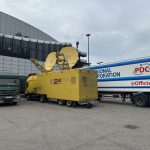A computer room air conditioning (CRAC) unit is a device that monitors and maintains the temperature, air distribution and humidity in a data center, network or server room. CRAC units replace the air conditioning (AC) units used in the past to cool data centers. By comparison, CRAC systems have better air filtration, better humidity control mechanisms and higher airflow than typical AC systems.
CRAC units, which are a type of heating, ventilation and air conditioning (HVAC) system, help prevent low humidity levels and water vapor from forming. Low humidity can cause static electricity buildup, which can result in electrostatic discharge (ESD) that could damage electronics in computer equipment, and water vapor buildup, which can cause short circuits and corrode equipment. CRAC units are generally more efficient than air conditioning systems and are designed for medium to large data centers. It is a good idea, though, to have portable air conditioning units available in case of a CRAC system failure or scheduled downtime.
Computer room air conditioning units work using a mechanical refrigeration cycle where air is blown over a cooling coil filled with refrigerant. Refrigerant in the cooling coil is kept cold by a compressor.
Excess heat is expelled as air, water or a glycol mixture. Older computer room air conditioners can only turn on and off, while newer units enable different airflow variations and have greater energy efficiency and cooling capacity.
There are various ways that CRAC units can be situated. One popular CRAC setup is having cooling air dispensed through an elevated floor. Also called raised flooring, the cooled air rises through the perforated floor sections, forming cold aisles. The cold air flows through the racks, where it picks up heat before exiting from the rear of the racks. The warm exit air forms hot aisles behind the racks, and the hot air returns to the CRAC intakes, which are positioned above the floor.
Components of a CRAC unit
CRAC units include the following components:
- Refrigerant. This is a chemical compound that is used as a coolant in CRAC and air conditioners.
- Cooling coils. Refrigerant flows through the cooling coils — also called evaporator coils — to cool the air.
- Compressors. The compressor keeps the refrigerant running through the coil cool.
- Air filters. These filters help catch the accumulation of dirt or dust that travels through a CRAC unit.
- Electronically commutated fans. EC fans blow cool air while producing less heat with high efficiency.
- Humidifiers and dehumidifiers. Although these are optional in CRAC systems, if needed, humidifiers increase the amount of moisture in the air, while dehumidifiers remove water vapor from the air.
What are the differences between CRAC and CRAH units?
Computer room air handler (CRAH) units are another data center cooling device. The main difference between CRAH and CRAC units is how they cool their surrounding environments. CRAC units use both refrigerants and compressors, while CRAH units use chilled water and control valves.
CRAH units use fans to blow air over cooling coils. Instead of the coils being filled with refrigerant, however, they’re filled with chilled water. Warm air from the data center room is drawn back into the CRAH unit, passing over the chilled water coils. The heat transfers from the air to the water, where the water then returns to a chiller.
Because CRAH units don’t need a compressor, they consume less energy and are more efficient than CRAC units. This makes them more suitable for sustainable data centers.
CRAC units are ideal for data centers with electrical loads of 200 kilowatts (kW) or less. Meanwhile, CRAH units are designed for data centers with electrical loads of 200 kW or more. CRAH units are also ideal for environments with high availability requirements.
Pros and cons of computer room air conditioning
Because the equipment generally found in data centers generates a lot of heat, some sort of cooling is essential to maintain the proper temperature and humidity. As noted earlier, CRAC units establish a proper environment for equipment by providing the recommended air filtration, temperature and humidity control, and airflow. This minimizes static electricity and water vapor buildup, both of which can damage equipment.
Challenges include costs for a CRAC system, such as the following:
- Design, installation, testing and maintenance.
- Managing system operation to ensure the correct operating environment can be maintained.
- Having resources to regularly test the ambient environment to ensure optimum CRAC performance.
Advanced technology for data center cooling
Today’s data centers take advantage of the many advancements in data center environment and operations management. Among these are smart assistants that use AI and machine learning (ML) to monitor facilities efficiently and activate adjustments to HVAC systems to maintain temperature and humidity levels. AI-based HVAC management of heat output and cooling usage can result in energy savings.
Real-time monitoring of temperature and humidity level can be aided by robots that systematically move throughout the data center, capturing equipment cabinet and rack temperatures and humidity levels.
CRAC system planning considerations
Building or updating a data center is a complex task. When it comes to heating and cooling, the following steps should be part of the planning process:
- Examine existing systems to see if their energy efficiency is appropriate for the currently installed and new equipment.
- New data centers will need to start at the design stage when determining heating and cooling requirements.
- Identify situations where existing components, such as thermostats, are not performing properly.
- Identify and work with experienced HVAC engineers when developing the design for a new data center or updating an existing one.
- If a chilled water facility is needed, the HVAC engineer can provide guidance on a suitable location.
- Vendors with experience in data center design should be considered, especially when configuring underfloor air flow and piping for water and/or coolant delivery.
- The HVAC plant should be scalable to accommodate changes in data center operations.
- Ensure that the primary CRAC system has suitable backups, including emergency power, to ensure uninterrupted operation.
Manufacturers of computer room air conditioning systems
The following is a list of CRAC system manufacturers:
- Airedale by Modine.
- Green Revolution Cooling.
- Hitachi.
- Mee Industries.
- Mitsubishi Electric.
- Nortek Air Solutions.
- Rittal.
- Schneider Electric.
- Silent-Aire.
- Stulz.
- Vertiv.
The future of data center cooling system technologies
As data centers increase in complexity and size, HVAC technologies will need to keep in step to optimize data center performance. Liquid cooling systems using water or coolants are widely used today, and new data center cooling technologies are likely to appear in the coming years. These can include geothermal cooling and smart technologies using AI to more efficiently and environmentally monitor and manage cooling activities.
Learn more about the cooling systems used in data centers and how liquid and air cooling compare.















